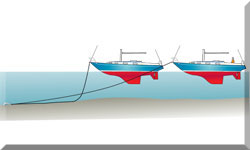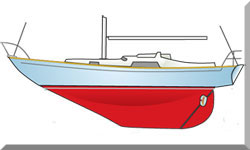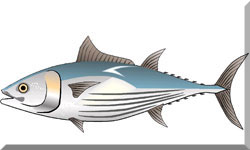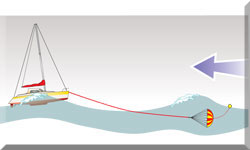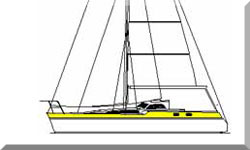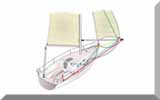- Home
- Offshore Sailing
- Sailboat Flag Etiquette
- Sailboat Flag Etiquette Issues
Sailboat Flag Etiquette: Your Questions Answered
Whether you're a seasoned sailor or a curious newcomer to the world of boating, understanding the tradition and significance of flag protocols can add a touch of professionalism and respect to your time on the water.
Here we address common questions about the do’s and don’ts of displaying flags, their meanings, and how they enhance communication among mariners.
What is the purpose of the ensign, and where should it be flown?
What is the purpose of the ensign, and where should it be flown?
The ensign is the primary flag that identifies the nationality of a vessel. It’s a symbol of pride and tradition, connecting sailors to their country’s maritime heritage. It is traditionally flown at the stern of the boat, whether at anchor, in port, or underway. For most sailors, it’s raised at 8:00 AM and lowered at sunset in keeping with naval customs.
If the stern is obstructed by equipment like a wind vane or solar panels, the ensign can be flown from an alternate position such as a gaff or the leech of the mainsail. It’s important to ensure the ensign is the right size for your boat; generally, one inch of flag length is used for every foot of boat length.
What is a burgee, and how is it different from other flags?
What is a burgee, and how is it different from other flags?
A burgee is a distinctive flag that represents membership in a specific yacht club or sailing organization. Unlike national flags, it’s more decorative and personal, often triangular or swallow-tailed, with unique designs that reflect the history or identity of the club.
Sailors typically fly a burgee from the masthead or starboard spreader, depending on the rigging. Beyond its visual appeal, a burgee is a great way to connect with other club members when you encounter them on the water or at port.
What are courtesy flags, and when should they be displayed?
What are courtesy flags, and when should they be displayed?
Courtesy flags are small versions of a country’s national flag flown by foreign vessels as a gesture of respect when entering that country’s waters. They are usually hoisted on the starboard spreader after clearing customs and serve as a clear signal of compliance with local maritime practices.
Before clearing customs, you should fly the yellow quarantine flag (also called the “Q” flag) to indicate that formalities are pending. Because courtesy flags endure a lot of wear from salt, wind, and sun, experienced sailors often bring spares for the countries they plan to visit, especially in regions where borders are close together.
What is the correct order of precedence for flying flags on a sailboat?
What is the correct order of precedence for flying flags on a sailboat?
Flag precedence is all about honouring tradition and maintaining clarity. The national ensign has the highest priority and is always flown at the stern of the boat. Yacht club burgees come next and are usually displayed at the masthead or starboard spreader.
Courtesy flags are positioned beneath the burgee on the starboard spreader if visiting a foreign country. Personal signals, such as custom-designed flags representing the owner, have lower precedence and are often flown on the port spreader or another less prominent location.
By following this order, you’ll ensure clear and respectful communication with other sailors and authorities.
Are there specific rules for flying flags in international waters?
Are there specific rules for flying flags in international waters?
In international waters, where no single nation’s rules apply, sailors adhere to maritime customs to maintain mutual respect and effective communication. The national ensign should still be flown to identify your vessel’s nationality.
When you enter a foreign country’s territorial waters, it’s customary to raise a courtesy flag to show respect for the host nation. Additionally, certain signal flags, like those indicating quarantine, distress, or participation in a regatta, may be necessary to communicate specific statuses to nearby vessels or authorities.
What are private signals, and who can use them?
What are private signals, and who can use them?
Private signals are personalized flags that reflect the identity of the vessel’s owner or skipper. They are often custom-designed to include symbols, logos, or family crests that hold personal significance. These flags are generally flown on the port spreader and add a personal touch, especially during formal maritime events like regattas or ceremonies.
Only the vessel’s owner or someone authorized by them can use a private signal, making it a unique and individualized tradition among experienced sailors.
What are the rules for flying multiple flags on the same halyard?
What are the rules for flying multiple flags on the same halyard?
When flying multiple flags on the same halyard, it’s important to keep the flag of highest precedence at the top. This ensures that the order of importance is respected and avoids sending mixed signals.
Adequate spacing between flags is essential to prevent tangling, and you should avoid overcrowding a single halyard.
In busy scenarios, such as regattas, it’s common practice to remove non-essential flags temporarily to ensure clear and effective communication with other vessels.
What are the consequences of not adhering to flag etiquette?
What are the consequences of not adhering to flag etiquette?
Failing to follow proper flag etiquette can lead to misunderstandings, disrespect, or even legal repercussions in some cases. In certain countries, improper use of a national flag could result in fines or other penalties.
Within the sailing community, disregarding these traditions might harm your reputation, as flag etiquette is highly regarded among seasoned sailors.
By adhering to these customs, you show respect to the maritime community and help ensure smooth interactions with others.
How should flags be maintained to avoid causing offense?
How should flags be maintained to avoid causing offense?
Maintaining your flags properly is crucial to avoiding unintentional disrespect. Flags should be regularly cleaned with fresh water to remove salt and dirt, then thoroughly dried before being stored in a well-ventilated, cool space.
Prolonged exposure to sunlight can fade colours and weaken fabric, so storing flags in UV-protected bags when not in use is a good idea. Frequent inspections ensure that any damaged flags can be replaced before they’re flown, keeping your displays neat and respectful.
What are the traditions and laws regarding special ensigns?
What are the traditions and laws regarding special ensigns?
Special ensigns hold ceremonial and historical significance and are often governed by strict regulations. Some yacht clubs issue warrants to their members, granting them the privilege of flying a unique club ensign. These flags often symbolize the club’s history and prestige and must be used in compliance with the issuing authority’s rules.
Unauthorized use of special ensigns is typically prohibited and may lead to penalties, especially in countries with a strong maritime tradition like the United Kingdom.
For authorized sailors, flying a special ensign is a proud statement of their club affiliation and status.
Recent Articles
-
Which Type of Boat Fridge Is The Most Efficient?
Apr 24, 25 05:06 AM
The top opening boat fridge is reputed to be more efficient than the front opening type, but that may not be the case - and here, amongst other boat refrigeration considerations, is why -
Multihull Autopilot Selection is Not Straightforward
Apr 19, 25 01:25 PM
Whether its for a catamaran or a trimaran, tiller or wheel steered, a multi hull autopilot must be endowed with specific performance characteristics... -
Wheel-Steering Autopilots: Your Questions Answered...
Apr 18, 25 03:45 PM
Whatever your question, you should find the answer here

